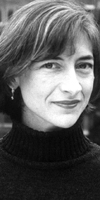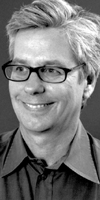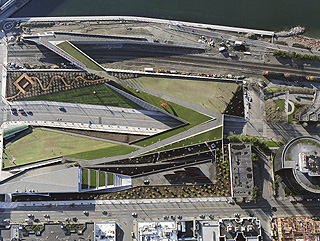
DJC.COM
January 18, 2007
Park fits Seattle to a Z
Weiss/Manfredi

Weiss
|

Manfredi
|
Art, ecology, landscape, infrastructure and urban life are often viewed as separate and incompatible. Our own practice was formed from a conviction that these diverse disciplines are strongest when envisioned as reciprocal and supportive rather than separated by the administrative barriers of disciplinary boundaries.
When the competition for the future Olympic Sculpture Park was announced in 2000, we were struck by the once-in-a-lifetime opportunity the project presented.
Everything we were passionate about: art, urban life, landscape, infrastructure and architecture were central to the Seattle Art Museum’s mandate. The museum’s challenge was exceptional: as a cultural endeavor the sculpture park could circumvent the typical relationship of art inside the museum and offer a radical alternative — art and design as part of the public realm.
Connecting city and sound

Photo by http://www.sky-pix.com The 2,200-foot Z-shaped path rises over Elliott Avenue and the railroad tracks to create an uninterrupted landform. |
For us, Seattle is a remarkable combination of vital urban life and extraordinary natural beauty. This project, in this city, had no precedents.
Most sculpture parks are destinations remote from the city, and most urban sculpture parks exist behind the protective walls of a museum. Certainly no sculpture park can claim such a spectacular location, both on the water and in the heart of the city. We knew the Seattle Art Museum was a pioneer in the revitalization of downtown and had the vision to take on the immense challenges and opportunities that the site presented.
Standing between the city and the water, we wondered what transformation would capitalize on the train lines and roadways that divided the site. How could a design generate new connections between the city and Puget Sound? How might this project illuminate the immeasurable power of art and landscape together?
The genesis of our design originated with these questions. Our ambition was to establish connections where separations existed, bringing art to the public and the public to the park. The competition design we presented at the public presentation in 2001 reflected our conviction that a strong and simple strategy would provide a resilient framework to invite change and evolution while sustaining a legible identity in the city.
The Z-path
Our design, a Z-shaped topography that wandered from the city to the water’s edge, was sculpted to rise over the existing infrastructure to create an uninterrupted landform for sculpture. As a new armature for art, this park would offer topographically diverse landscapes to view the art and the surrounding city and sound.
This strategy embraced the museum’s competition mandate to create a rich variety of native landscapes within the context of one park.
Now, six years later, it is especially exciting to see the realization of this concept.
The unfolding landscape begins at the city with a transparent steel and glass pavilion for art, performances and educational activities, and offers views of the sound and Olympic Mountains.
From the pavilion, the 2,200-foot Z-path links three emblematic settings: the valley, an archetypal forested landscape of the Northwest; the grove, a deciduous forest adaptable to the city; and the shore, a waterfront setting shaped by wind, saltwater and a regenerative underwater landscape for fish and wildlife.
Along the Z-path, directed views intensify the perception of radically different prospects, northwest to the sound and mountains and southeast to the city and port.
Throughout the design, seemingly parallel lines converge, accentuating the laws of perspective to suggest infinite distances throughout the park.
Deliberately open-ended, the park invites new interpretations of art, environmental engagement and simple pleasure. The Olympic Sculpture Park connects art, landscape and urban life, stimulating ever-changing views of the role of art in the landscape and a park in the city.
Marion Weiss and Michael Manfredi are the founders of Weiss/Manfredi, a multidisciplinary design practice based in New York City.
Other Stories:
- Sculpting an oasis from a blighted landscape
- Risky site inspired creative thinking
- Landscape grounded in Northwest natural history
- Engineering the path took a lot of twists and turns
- Complicated project packs a few surprises
Copyright ©2009 Seattle Daily Journal and DJC.COM.
Comments? Questions? Contact us.